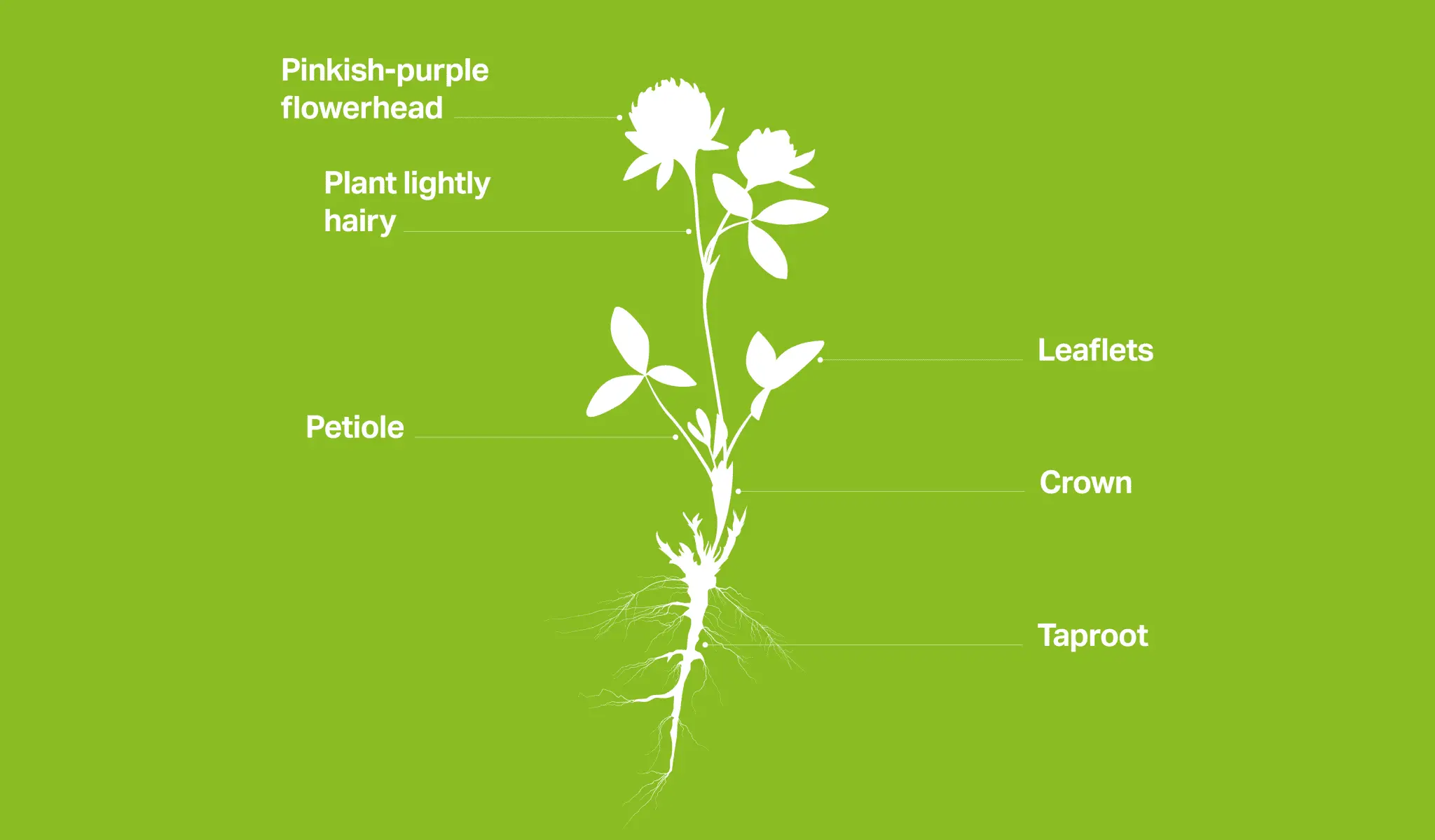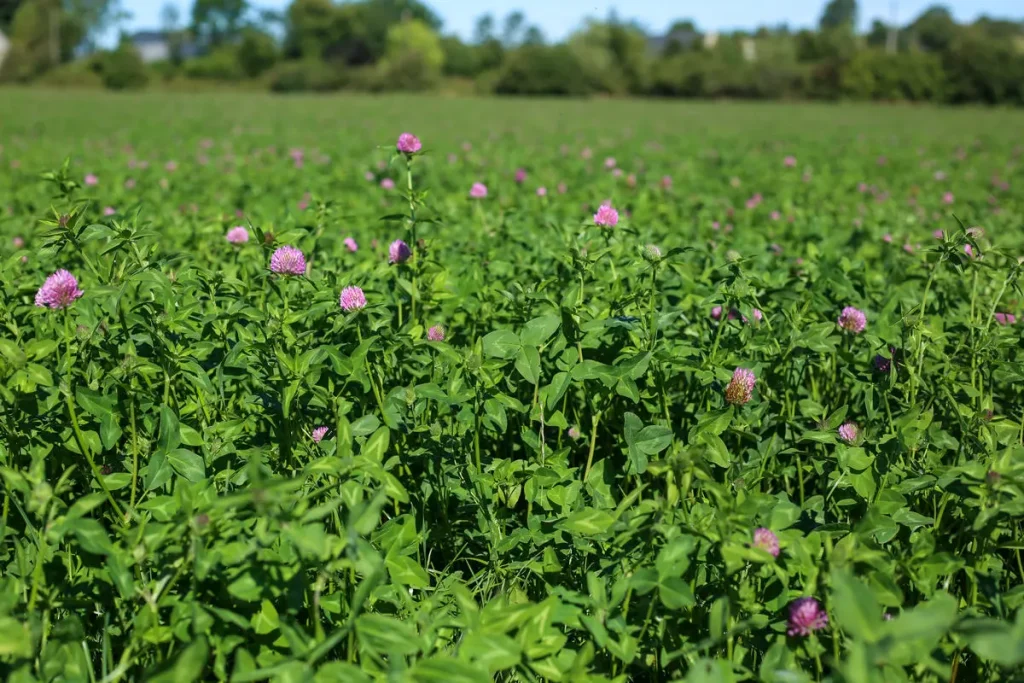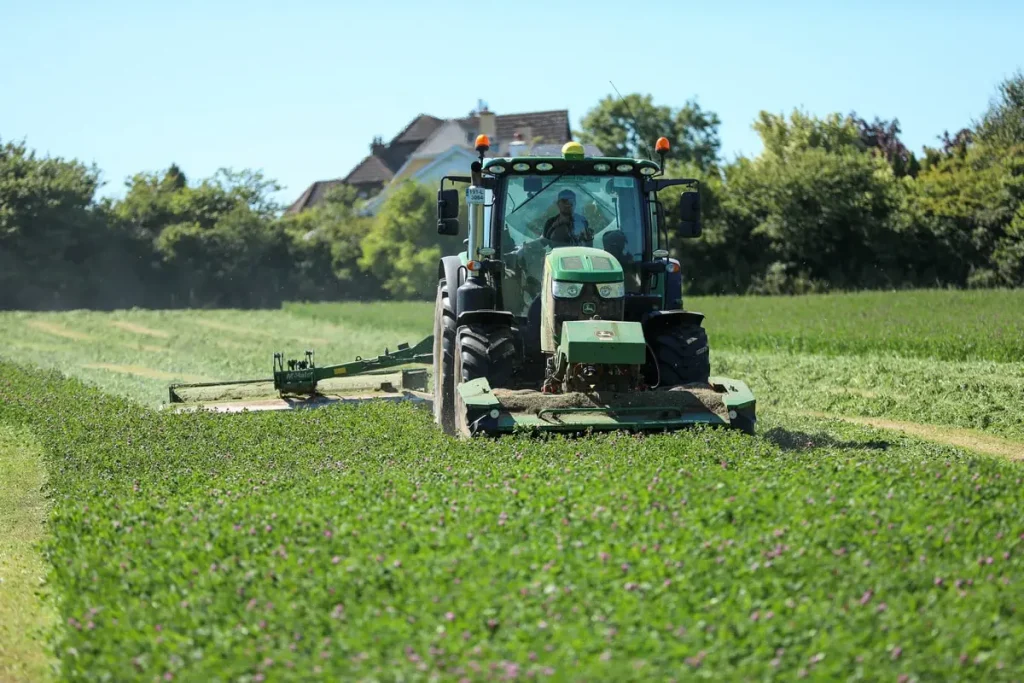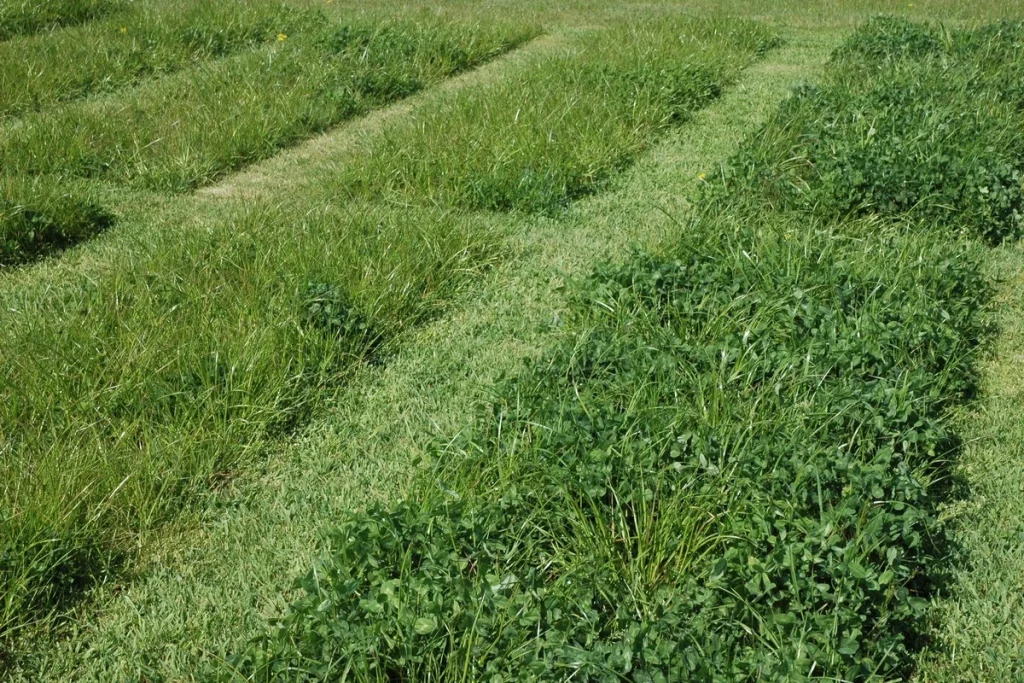Red clover seed is best grown as part of a grass/clover sward, but can also be grown as a monoculture, primarily to provide high yields of protein-rich forage for conservation.
Contents
- Understanding red clover
- Successful establishment of red clover seed
- Sward renovation
- Combating pests and diseases
- Cutting and grazing heights
- Bloat awareness
- Key developments
- Red clover seed varieties
What is red clover?
Red clover (Trifolium pratense) is a short-lived perennial herbage legume that typically persists for two-to-four years. In contrast to white clover, it has an upright growth form and a strong deep tap root from which finer roots arise.
The crown, located at the base of the stem, acts as a store of nutrients. Differences in the size and reserve status of the crown affect persistency and suitability for particular management regimes.

Source: Germinal
The development of more grazing tolerant and persistent varieties is creating the potential for this grassland species in rotational grazing systems, and it also has value as a break crop that improves soil structure and fertility.
Key benefits of planting red clover
- Nitrogen fixation – Rhizobium bacteria exist symbiotically within root nodules and produce available nitrogen, the same as white clover and other legumes. Discover more about clover's nitrogen fixing qualities here.
- High yields – red clover swards can produce 10-15 t DM/ha/yr.
- Feed value – protein content is particularly high in this clover, and – due to a form of biochemical protection – there is a reduction in protein loss in the silo. Feed value is greater than it appears on analyses due to the composition of the protein, and exceptional finishing results can be achieved.
- Break cropping – red clover seed can provide significant benefits as a break crop in mixed farming situations due to its ability to improve soil structure and soil nutrient status.
- Multi-species swards – can be included in multi-species and herbal leys
Successful establishment of red clover seed
Targets
The aim when establishing a red clover grass ley is to achieve 200 plants per square metre by October in the sowing year.
Techniques: How to grow red clover
Red clover seed can be drilled or broadcast and can be undersown to an arable silage crop in April. It can be introduced into an existing sward.
Timing: When to sow red clover seed in UK?
March/April or August are the optimum times for sowing red clover seed on the majority of UK farms.
Seedbed
- A fine, firm seedbed is essential, and this should ideally be ring rolled prior to sowing.
- Soil pH should be 6.0 or above. Liming to correct pH should be carried out well in advance of sowing.
- Fertiliser nitrogen should only be applied in low N status soils, up to 50 kg N/ha.
- Phosphate (P2O5) and potash (K2O) is required at application rates of 50-120 kg/ha, to achieve soil indices of 2+.
Red clover seeding rate and sowing depth
Monoculture swards should be sown at 15 kg/ha (6 kg/acre). Seed rate for mixed swards should be 7 kg/ha (3 kg/acre) clover and 22 kg/ha (9 kg/acre) of hybrid ryegrass. Optimum seed depth is 5-10 mm and should never exceed 15 mm.
Monoculture or companion grass
Red clover seed is primarily grown in a mixed sward but can also be grown as a monoculture. Aber High Sugar Grass perennial ryegrasses are the best companion grasses.
Advantages of sowing red clover with a companion grass
- Reduced impact of poaching
- Improved nutritional balance (from Aber High Sugar Grass)
- Utilisation of fixed nitrogen by grass
- Less leaching of nitrogen into the environment
Intermediate and late heading Aber High Sugar Grasses at 20-24 kg/ha (8-10 kg/acre) with an Aber long-term red clover variety (e.g. AberClaret) at 7.5 kg/ha (3 kg/acre) have been shown to be an effective three-to-five-year ley mixture providing high yields of quality silage followed by late-season lamb grazing.
Sward renovation
Red clover has a large seed and vigorous seedlings and is suitable for overseeding into existing swards. This can offer a cost-effective improvement of soil fertility and soil structure.
A variety of methods can be used for growing red clover from seed, from slot seeding to broadcasting following scarification. The greatest success will be achieved by observing the following principles:
- Minimise competition from existing plants prior to sowing by heavy grazing and/or harrowing to open up the sward
- Observe normal sowing timings (April to August) and soil nutrient/pH status parameters
- Take advantage of the period when the grass is least vigorous (after flowering in July) if there is sufficient soil moisture, particularly after a silage cut
- Ensure soil is sufficiently disturbed to allow seed contact and coverage (5-10 mm seed depth)
- Use a seed rate of 7.5 kg/ha (3 kg/acre) to compensate for greater seedling loss.
- Use slug pellets as an established sward may well harbour this pest
- Graze lightly and in short periods until clover is well established
Please do not overseed red clover into an existing sward due to potential problems with sclerotina and stem eelworm.

Combating pests and diseases
Slugs can be particularly problematic in drilled crops and should be controlled to avoid damage during the establishment phase.
Clover rot (Sclerotinia) is the most important disease. This fungal disease, seen typically in December/January, causes a generalised rot of the crown, leaves and stems from which plants rarely recover. Clover rot cannot usually be controlled safely or economically in situ and hence a five-to-seven-year rotation is strongly recommended.
Stem eelworm is the most concerning pest and the most effective control is rotation. A five-year break is recommended between red clover crops, and this should be extended to seven years if stem eelworm is known to be present.
Crown and root rot (typically caused by Fusarium) and powdery mildew can also impact but are less devastating.
There are limited clover-safe agrochemicals for the prevention of pest and disease problems in clover. Products should only be used following advice from a qualified agronomist.
Weed control: First and foremost, a clean seedbed is essential in order to avoid competition from weed species during establishment.
Most annual and some perennial weeds can be controlled by regular pasture topping, but it may be necessary to use herbicides in some circumstances, in which case ensure a clover-safe product is used and only spray if clover plants are vigorous and well developed.
Cutting and grazing heights
As the crown is above ground, damage must be avoided to ensure plant survival:
- Cutting height for all silage cuts should be 7-8 cm minimum
- Optimum grazing height of aftermaths or over winter is 4-6 cm
- In wet weather, avoid heavy machinery and poaching
Systems in practice
- Conservation
- Graze swards lightly in the autumn of the sowing year
- Four cuts at 6-8-week intervals yielding 13-14 t DM/ha on fertile sites (10 t DM/ha on upland sites)
- Cut when between 30-50% of flowers show red, for optimum quality
- Ensile at 25-30% DM to minimise wilting losses
- Avoid crown damage caused by low cutting height
- Graze autumn re-growth lightly to finish lambs or cattle
- No nitrogen, 100-150 kg/ha K2O, 200-300 kg/ha P2O5
- 3-5 years good yields achievable with modern varieties
- Red clover in combination with Aber High Sugar Grasses results in a better fermentation

Grazing red clover
- Aftermath grazing for sheep
- Superior lamb growth rates compared with ryegrass
- Can be combined very effectively with Puna II perennial chicory and Tonic plantain (1 kg/acre Puna II + 1 kg/acre Tonic + 3.25 kg/acre red clover) for an outstanding lamb finishing mixture (Lamb Finisher)
- Grazing in wet or moist conditions must be avoided to limit bloat and reduce poaching
Organic
- Key conservation and fertility building crop for organic farms
- Typically undersown to spring barley
- Valuable break crop that improves soil nutrient status and soil structure
Typical analysis of red clover/ryegrass silage | |
Metabolisable energy | Up to 11.5 MJ/kg DM |
Crude protein | 14-19% |
pH | 4.00-4.50 |
Ammonia nitrogen | <5% of total nitrogen |
Lamb performance from grazed red clover or ryegrass
| Red clover | Ryegrass |
Growth rate (g/day) | 229 | 182 |
Days to finish | 40 | 49 |
Eye muscle depth (mm) | 27.10 | 25.90 |
Subcutaneous fat depth (mm) | 4.10 | 3.90 |
Cold carcass weight (kg) | 18.80 | 17.70 |
Killing out percentage (%) | 51 | 48 |
Source: IBERS
Bloat awareness
Bloat is the excessive build-up of gas (carbon dioxide and methane) in the rumen resulting in distress and possible death due to the exertion of pressure on the animal’s diaphragm, heart and lungs. Some legumes present an increased risk of bloat (due to the rapid breakdown of protein in the rumen) if the correct management is not applied.
Effective management procedures to minimise or eliminate the risks of bloat in livestock grazing clover-dense swards should include:
- Limiting access to swards when stock is first introduced
- Avoiding turnout of hungry stock
- Feeding high dry matter forage such as hay/straw prior to turnout
- Offering hay/straw at intervals (e.g. to dairy cows at milking times)
- Feeding an anti-bloat feed additive
- Monitoring livestock
Oestrogenic content
Red clover typically contains high levels of phyto-oestrogens, particularly formononetin, which can cause a reduction in ovulation rates in ewes. It is, therefore, advisable to avoid grazing varieties with ewes and rams in the period from six weeks before to six weeks after tupping.
Key developments
Species re-emergence
The growing interest in safe, traceable homegrown protein – together with continuing maintenance of organic farming systems – has resulted in significantly greater demand for red clover in recent years. This situation is set to continue as livestock farmers progress towards more sustainable systems and seek greater returns from homegrown forage.
This resurgence in the crop is being underpinned by a significant breeding commitment at IBERS Aberystwyth University following the recommencement of the programme in 1998. New varieties with greater persistency and stronger resistance to disease, offering better compatibility with modern farming systems, are now available.
Breeding objectives
The main objectives of IBERS’ red clover breeding programme are:
- Maximising yield
- Increasing persistency, maintaining yields into fourth year and beyond
- Greater resistance of pests and diseases, particularly of crown rot (Sclerotinia) and stem nematode (eelworm)
- Improving tolerance of grazing and trampling by selecting for strong crowns to allow greater flexibility in use (e.g. aftermath grazing)
- Improved winter survival of plants
- Extension of growing season through earlier spring growth
- Greater tolerance of environmental stresses, particularly drought
- Improved nutritional quality to enhance protein utilisation and reduce nitrogenous losses
- Enhanced polyphenol oxidase levels to prevent rapid degradation of plant proteins and lipids in rumen and in silage
Disease resistance
IBERS has an ongoing screening programme for resistance to diseases such as Sclerotinia and stem eelworm. Several breeding lines with improved resistance have been identified and these, along with resistant wild ecotypes that have been collected from around Europe and Asia, are being used to develop new varieties.
Greater persistency
One of the shortcomings after planting red clover seeds has been its relatively short persistence, typically remaining in the sward for just two to three years when a longer productive life would make it more compatible with medium-term leys.
Long-term trial plots at IBERS are now showing the results of breeding for longer-lived varieties, with fourth-year data revealing new varieties that are still producing in the region of 14 t DM/ha.
Over the four years, the new material is totalling around 60 t DM/ha compared with
40-45 t DM/ha from the controls.
The AberClaret variety from our Germinal Horizon breeding programme features high on the Recommended Grass and Clover List.
The long-term breeding programme continues, with new varieties to rival AberClaret already in the advanced stages of development.

Improved nitrogen use efficiency
Nitrate pollution is a longstanding issue of water quality in the UK and there is now EU legislation that includes the Nitrates Directive and the Water Framework Directive. Many livestock farmers in the UK will be familiar with Nitrate Vulnerable Zones (NVZ) and hence there is awareness of the need to improve efficient utilisation and retention of plant-available forms of nitrogen.
In the case of red clover, research at IBERS covers several areas of nitrogen use efficiency (NUE). These include improving the uptake of nitrogen from the soil (reduced leaching) and the reduction of nitrogen losses in the silo (increased retention through increased PPO activity).
Polyphenol oxidase (PPO)
Work is currently underway to increase levels of polyphenol oxidase (PPO) in red clover. PPO is an enzyme that plays a role in the protection of protein and lipids from degradation both in the rumen and under silage.
A proportion of the protein content of red clover is lost through oxidation under silage. In less than optimal conditions, this can be as high as 30% of the overall content, with the nitrogen content of the degraded protein being lost through leaching. Similarly, a large proportion of plant proteins are degraded in the rumen, resulting in its loss before there is any potential for digestion by the grazing animal.
Enhancing PPO levels can help retention of protein through silage and digestion, maximising the nutritional qualities of the forage and preventing loss of nitrogen to the environment. Likewise, PPO protects plant membrane lipids during silage and in the rumen. This can have a knock-on effect on the fatty acid profile of the milk by increasing polyunsaturated fatty acids and decreasing saturated fats in milk of cattle fed on red clover.
Red clover seed varieties
New generation Aber Long Term Red Clover
Bred and selected by plant breeders at IBERS, these unique varieties have been selected to last four years and longer in a cutting sward and to be significantly more tolerant of grazing by dairy animals.
Dry matter yields in IBERS trials were in excess of 14,000 kg of dry matter in the fourth year and averaged over 13,500 kg in each year of the trial.
IBERS’ clover breeders understood that on many livestock farms a two-to-three-year crop of red clover does not fit in with general rotations. Hence, by closely selecting plants for survival under grazed and cutting conditions, they have dramatically extended the life of red clover leys.
These Aber Long Term Red Clover varieties are a step forward in breeding and as such it is important to look at the companion grasses that are used when growing red clover pasture seed.
To improve silage quality and to ensure that the grass also remains in the sward, the recommendation is to use Aber High Sugar intermediate and late perennial ryegrass varieties.
AberClaret
The first of the new generation Aber Long Term Red Clovers, AberClaret has been extensively trialled at IBERS over four harvest years, significantly out-yielding and out-lasting established varieties like Merviot and Milvus. AberClaret was the longest-lasting variety still producing over 14.6 t DM/ha in year four.
Red clover grass seed mixtures for ensiling performance
Intermediate or late heading perennial ryegrasses are ideal companion grasses for conventionally cut red clover mixtures.
Also, as red clover is relatively low in water-soluble carbohydrates, using Aber High Sugar Grasses will increase the sugar levels overall and improve the ensiling process.
With the availability of longer-lasting red clovers, a new mixture called Aber Red 5 HSG offers a breakthrough in silage production.
Ask Germinal about clover
White clover seed guide
